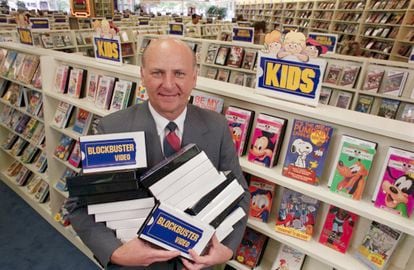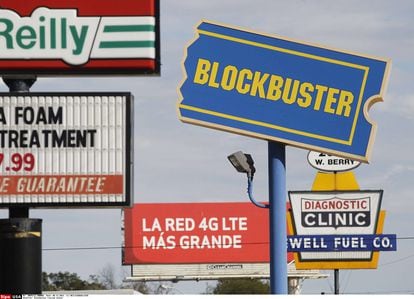The Blockbuster trap: A love letter to the video store, by the company that destroyed it
A new Netflix comedy set in the last remaining franchise of the chain evokes the good old times before streaming was available
/cloudfront-eu-central-1.images.arcpublishing.com/prisa/T7452M4TTZFMTLJYDEDZXFNBFQ.jpg)
The cruel irony couldn’t be more obvious: Netflix is profiting off the nostalgia for Blockbuster’s video rental stores. The streaming platform, regarded by some as responsible for the death of the movie rental business model, just premiered a comedy series set in the last remaining Blockbuster in the world. Simply titled Blockbuster, the show is inspired on the true story of the establishment in Bend, Oregon, that in 2019 became the company’s last franchise in the world, a story that previously inspired the documentary The Last Blockbuster (2020), which was the fourth most watched content on Netflix during the spring of 2021 in the United States.
Starring Randall Park and Melissa Fumero, Blockbuster explores with humor its own contradictory nature from episode one, with a customer going to the store to complain about Netflix’s algorithm, which was recommending the kind of shows that his ex-girlfriend, with whom he shared his account, used to like, even though she had just left him. The manager and employees immediately get to work searching and recommending the most appropriate movies to overcome a breakup, like Eternal Sunshine of the Spotless Mind or Midsommar.
Beyond the occasional winks, however, the stories here are not by any means incisive towards the new forms of consumption, nor do they have much to do with cinema. In that sense, Blockbuster is faithful to the conclusions drawn by the documentary, expressed by one of the company’s vice presidents: that nostalgia for the franchise has to do with the whole experience surrounding the ritual of going there to pick a movie, or the fixation of those who were children at the time with the brand, the stores and the colors, as characteristic as those of McDonald’s or Burger King.
It is in fact the documentary the one that questions, with much more malice, the role played by the company in the cinematographic culture of its time and in the very field which it now symbolizes. Blockbuster, which came to have more than 9,000 stores (5,000 of them in the United States alone) and which, at its peak, opened one every 17 hours, developed monopolistic practices against other video stores that could hardly be considered good for competition, and whose owners were invited to become Blockbuster franchisees or face the consequences of having one across the street.
“Blockbuster was the enemy, it crushed the neighborhood video stores,” says José Fernández Riveiro, author of Rebobinando: El libro de la generación del videoclub (Rewinding: The book of the video store generation), published this year, where he explores everything that surrounded the video store phenomenon in the 1980s and 1990s, the circumstances it generated and its impact on the film industry – like the proliferation of false sequels or imitations (such as the Italian Alien 2: On Earth, from 1980, or Star Crash from 1978). “Additionally, directors like Sam Raimi, with his Evil Dead trilogy, or Peter Jackson with Bad Taste and Braindead, made a career thanks to that culture, because, due to the video stores, the presence of their films in home-viewing format lasted much longer,” explains the writer.

It was a culture that clashed squarely with the policies of a giant like Blockbuster: its decision not to offer titles for viewers over 17 years of age had a huge influence on the studios, which had to be cautious when it came to producing films that might not make it to the most important rental space in the world. In The Last Blockbuster, Lloyd Kaufman, co-founder of Troma Entertainment and director of The Toxic Avenger (1984) – the quintessential video store fodder – claims to have requested a meeting with Blockbuster executives to ask them to carry his films, only to be faced with ridicule: “They were rude, they were scumbags, they had no respect,” he said, referring to their logo as the “greatest American symbol of true monopoly.”
Staff picks
The video store was born in 1975 when a German man named Eckhard Baum, in the city of Kassel, started to lend his Super 8 films to his neighbors. Those who owned a player for their family recordings could now watch Hollywood movies in their own living room. After seeing the interest that the idea aroused, he decided to turn it into a business and began to rent them. The business model reached the United States in 1977, with the first one opening in Los Angeles, and became enormously popular in the 1980s thanks to the practicality of the Betamax format, first, and then the VHS, which would prevail for many years until the arrival of the DVD.
A part of the legacy of sentimental and cinematographic education that the video stores left behind is embodied in the figure of the employee who worked there. Directors like Kevin Smith, with Clerks, or Quentin Tarantino, who on many occasions has talked about how his work in a video store and his conversations with the customers became essential in his development as a filmmaker, have fueled the mythical notion of the loquacious and passionate character who, from behind the counter, acted as a sort of curator of a massive and eclectic selection of films.

“That figure existed, of course,” says Fernández Riveiro. “The video store clerks were peculiar characters and many groups of friends used to form around them and the movies. Lots of heated discussions, too! And they worked better than the algorithms as they got to know your tastes, because they were more personal and they didn’t try to make you watch the same type of movie all the time, like the platforms do.”
In the Blockbuster series, a narrative that almost feels like science fiction focuses on a receding consumer element that is closely linked to the video store: the movies in physical format. Movies whose online availability generates a false feeling of permanence. A clear example that calls this into question are the original productions made specifically for HBO Max that, for tax reasons, the platform’s owner, Warner, decided to remove this summer: among others, The Witches, An American Pickle and the acclaimed animated series Infinity Train.
Another emblematic film of the video store world, the comedy Be Kind Rewind (2008), about two managers of a video store who have to remake all the VHS movies themselves after an accident erases them, brought up something more transcendental about these establishments: that what these tangible physical movies contained was not the most important part, but rather the neighborhood experience of meeting and participating around cinema.

It is a similar idea to the one mentioned by the journalist Matt Goldberg in the article “The Necessary Evil and Unnecessary Nostalgia for Blockbuster Video,” published in Collider.com: “We long for the communal aspect of going out with some friends to the store and conversing about what we wanted to see. [...] It would be nice if there were a resurgence of the independent video store because what we’re longing for isn’t Blockbuster or even selection, but a place to gather and share a love of movies surrounded by a wealth of cinema — not ‘content.’”

/cloudfront-eu-central-1.images.arcpublishing.com/prisa/WD56JP7TCBGNDJJGA5XUBCQA7M.jpg)










































